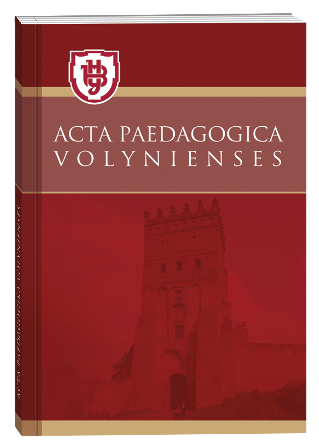EDUCATIONAL FUNCTIONS OF CHILDREN’S TOYS IN THE EDUCATIONAL PROCESS OF MODERN PRESCHOOL INSTITUTIONS
DOI:
https://doi.org/10.32782/apv/2025.1.7Keywords:
toy, competency-based approach, cognitive activity, mental operations, national characteristics, educational environmentAbstract
The article «Educational Functions of Children’s Toys in the Educational Process of Modern Preschool Institutions» explores the multifaceted role of children’s toys in fostering cognitive, social, and emotional development in preschool- aged children. The study is grounded in a competency-based approach that emphasizes the role of toys as a didactic and developmental tool in modern educational environments. It outlines the various ways in which children’s toys contribute to cognitive stimulation, mental operations, and the acquisition of essential life skills. Furthermore, the article examines the cultural significance of toys, particularly folk toys, in enhancing children’s awareness of national heritage and values, while also serving as a bridge for social interactions in a multicultural setting.A key focus of the research is the function of toys in shaping children’s cognitive activity. The article discusses how toys stimulate curiosity, imagination, problem-solving skills, and logical reasoning. It argues that structured play with educational toys enhances cognitive development by promoting mental operations such as classification, comparison, generalization, and analysis. The role of toys in developing memory and concentration skills is also highlighted, showing that engagement with toys designed for educational purposes significantly contributes to a child’s ability to process and retain new information.Another important aspect explored in the study is the socializing function of toys in preschool education. The article emphasizes that toys serve as a medium for fostering interpersonal relationships, cooperation, and communication among children. Through shared play experiences, children learn fundamental social behaviors such as turn-taking, empathy, and conflict resolution. The study underscores the importance of toys that encourage group play, as they provide opportunities for children to practice and internalize essential social norms and values.The cultural dimension of toys is given particular attention, with a discussion on the role of folk toys in preserving national identity and cultural heritage. The article examines how the introduction of traditional toys in preschool settings can contribute to children’s understanding of their own culture and heritage while simultaneously fostering respect for cultural diversity. By engaging with folk toys, children develop an appreciation for craftsmanship, storytelling traditions, and the values embedded within their national culture. This aspect is particularly relevant in today’s increasingly globalized and multicultural world, where fostering cultural awareness from an early age is essential for social harmony and integration. Moreover, the article analyzes the impact of the educational environment on the effectiveness of toy-based learning.It highlights the role of educators in selecting appropriate toys that align with educational objectives and developmental needs. The study emphasizes that teachers should be aware of the didactic potential of different types of toys and incorporate them effectively into their teaching strategies. Additionally, it discusses the importance of organizing play spaces that stimulate exploration and creativity, ensuring that toys are accessible, diverse, and adaptable to different learning styles and needs.The article also delves into the psychological benefits of toys, particularly in relation to emotional regulation and stress relief. It explores how engaging with toys helps children manage their emotions, express their feelings, and develop coping strategies. Therapeutic play with specific types of toys, such as sensory toys and dolls, is discussed as a valuable method for supporting children’s emotional well-being. The research suggests that well-designed toys can contribute to the development of emotional intelligence, self-regulation, and resilience in young children.Additionally, the article provides an overview of modern trends in toy development and their implications for preschool education. It examines the role of technological advancements in shaping contemporary toys, including the integration of digital elements and interactive features. While acknowledging the benefits of digital toys in enhancing engagement and learning outcomes, the article also raises concerns about potential drawbacks, such as reduced physical activity and overreliance on screens. The study advocates for a balanced approach that incorporates both traditional and digital toys to maximize the benefits of play-based learning.In conclusion, the article underscores the essential role of children’s toys in the educational process of modern preschool institutions. It highlights the didactic, social, cultural, and psychological functions of toys, demonstrating their significance in fostering holistic development in early childhood. The research advocates for a thoughtful and strategic integration of toys into preschool curricula, ensuring that they serve as effective tools for cognitive stimulation, socialization, cultural awareness, and emotional well-being. By leveraging the educational potential of toys, preschool educators can create enriching learning experiences that lay the foundation for children’s lifelong development and success.
References
Aries P. Centuries of Childhood : A social History of Family Life / P. Aries . Harmondsworth : Penguin, 1986.
Артемова Л. Актуальні проблеми виховання дітей в поліетнічному дошкільному закладі . Вісник психології і педагогіки. Педагогічний інститут Київського університету імені Бориса Грінченка. Випуск 13. К., 2013.
Батухміна О. Формування елементів національної культури у дітей шостого року життя засобами української народної іграшки. Дис. ... канд.пед. Наук. Київ, 2008. 848 с.
Бех І. Д. Виховання особистості: Сходження до духовності: наук. видання / І. Д. Бех. К. : Либідь. 2006. 272 с.
Герус Л. М. Українська народна іграшка кінця ХШХ – першої половини ХХ століття (історія, типологія, художні особливості): Л. : Світ. 1997.
Гладун Л. Щоб іграшка була корисною. Вихователь – методист дошкільного закладу. 2009. № 12. С. 33–35.
Гроос К. Духовне життя дитини / Н. В. Кудикіна. Теорія ігрової діяльності дітей : монографія. Київ : Вид.-во Київського університету імені Бориса Грінченка. Педагогічний інститут. 2012. 229 с.
Кудикіна Н. В. Досвід використання гри як засобу національно – культурного виховання дітей молодшого шкільного віку. Наук. зап. Ніжинського держ. пед . ун-ту ім. М. Гоголя. Серія : Педагогічні науки. 2002. № 3. С. 75–78.
Найден О. С. Українська народна іграшка: Історія. Семантика. Образна своєрідність. Функціональні особливості. К. : АртЕк, 1999. 256 с.
Mead, Margaret. Coming of Age in Samoa: A Psychological Study of Primitive Youth for Western Civilisation. New York : William Morrow, 1928.
Mead, Margaret. Growing Up in New Guinea: A Comparative Study of Primitive Education. New York : William Morrow, 1930.







